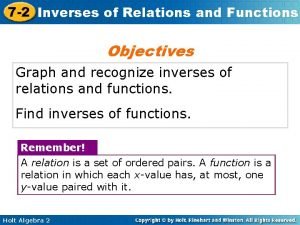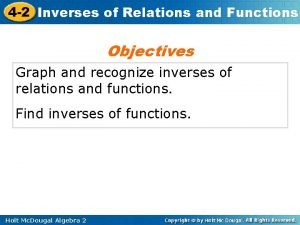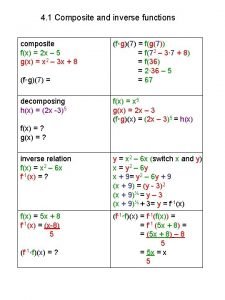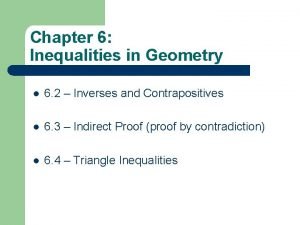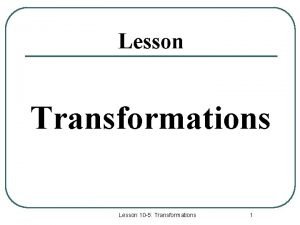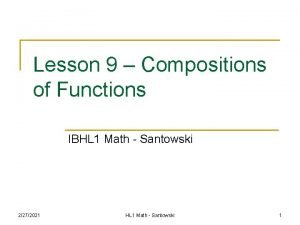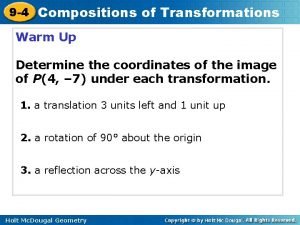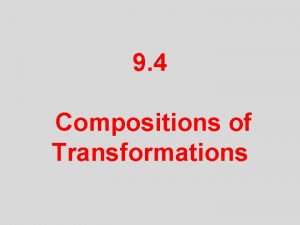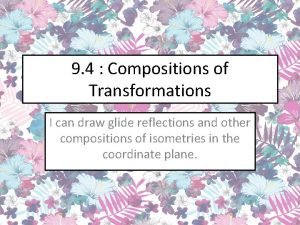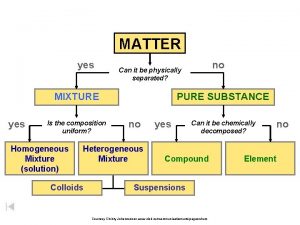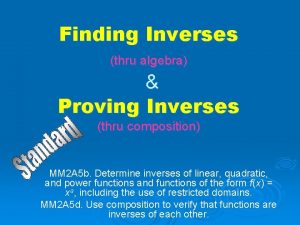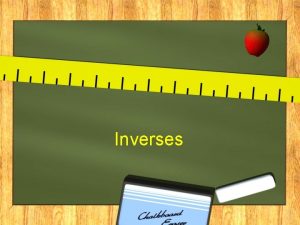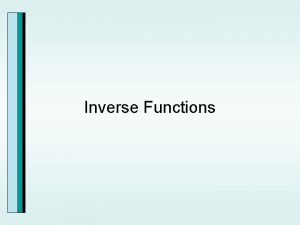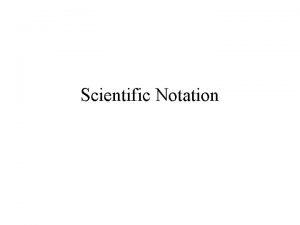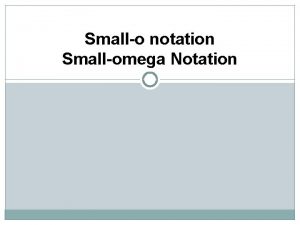Function Compositions and Inverses Function Notation fx does






















- Slides: 22

Function Compositions and Inverses

Function Notation • f(x) does NOT stand for MULTIPLICATION! • We read f(x) “f of x” and it means that the function’s independent variable is x. • If the function is defined as f(x) = 3 x - 1 and we are asked to find f(2), we just substitute 2 for x in the function: f(2) = 3(2) - 1 = 6 - 1 = 5

Function Substitutions 2 x Given g(x) = - x, find g(-3) Substitute -3 for x: 2 g(-3) = (-3) - (-3) = 12 g(-3) = 12

Function Substitutions 2 4 x Given g(x) = 3 x + 2, find g(5) Substitute 5 for x 2 g(5) = 3(5) - 4(5) + 2 = -83 g(5) = -83

Function Composition is just more substitution, very similar to what we have been doing with finding the value of a function. The difference is we will be substituting another function instead of a number. . .

Function Composition For example… Given f(x) = x - 5, find f(a+1) Substitute (a+1) for x f(a + 1) = (a + 1) - 5 = a+1 - 5 The answer is a function in terms of ‘a’ =a-4

Function Composition • Composition notation looks like g(f(x)) or f(g(x)), we read this ‘g of f of x’ or ‘f of g of x’. • We are given f(x) and g(x), the function inside the parentheses gets substituted into the other.

Function Composition Given the functions: f(x) = 2 x+2 & g(x) = 2 find f(g(x)) This notation tells us to substitute the g(x) function, 2, for x in the f(x) function: f (2) = 2(2)+2 =6

Function Composition Given the functions: g(x) = x - 5 & f(x) = x + 1 find f(g(x)) This notation tells us to substitute the g(x) function, x-5, for x in the f(x) function: f (x-5) = (x-5)+1 =x-4

Function Composition Reverse the composition: g(x) = x - 5 & f(x) = x + 1 find g(f(x)) This notation tells us to substitute the f(x) function, x+1, for x in the g(x) function: g(x+1) = (x+1)-5 =x-4

Function Composition In the last example, f(g(x)) and g(f(x)) had the same results. This is not always the case. Try this example: f(x) = x 2 + x & g(x) = x - 4 find f(g(x)) and g(f(x))

Function Composition f(x) = 2 x + x & g(x) = x - 4 1) f(g(x)) = f(x-4) = (x-4)2 + (x-4) = x 2 -8 x+16+x-4 = x 2 -7 x+12 2) g(f(x)) = g(x 2 + x ) = (x 2 + x )-4 = x 2 + x - 4

Function Composition New Example: Given f(x) = 2 x + 5 & g(x) = 8 + x find f(g(-5) & g(f(-5) 1) f(g(-5) : find g(-5) = 8 + (-5) = 3 then find f(3) = 2(3) + 5 = 11 2) g(f(-5)) : find f(-5) = 2(-5) + 5 = -5 then find g(-5) = 8 + (-5) = 3

Function Inverse Remember: a function is a set of ordered pairs (including lists of discrete points and also equations which give us infinite points), where no two points have the same xcoordinate. The Inverse of a function is the set of points where each point in the function is reversed, (y, x).

Function Inverse A function that is a list of ordered pairs is easy to find the inverse of: f(x) = {(1, 2), (2, 5), (3, -4), (4, 0)} The inverse is: f-1(x) = {(2, 1), (5, 2), (-4, 3), (0, 4)}

Function Inverse To find the inverse of a function that is written as an equation, like: f(x) = x + 7 We will: 1) Replace the function label, f(x) with y 2) Swap the variables, x and y 3) Solve the new equation for y

Function Inverse Find the Inverse of: f(x) = x + 7 Replace: y=x+7 Swap: x = y + 7 Solve: y = x - 7 f-1(x) = x - 7

Function Inverse Find the Inverse of: f(x) = 3 x - 4 Replace: y = 3 x - 4 Swap: x = 3 y - 4 Solve: 3 y = x + 4 y = (x + 4)/3 f-1(x) = (x + 4)/3

Function Inverse Find the Inverse of: f(x) = (2 x + 5)/3 Replace: y = (2 x + 5)/3 Swap: x = (2 y + 5)/3 Solve: 3 x = 2 y + 5 2 y = 3 x - 5 f-1(x) = (3 x - 5)/2

Function Inverse Find the Inverse of: f(x) = x 2 - 4 Replace: y = x 2 - 4 Swap: x = y 2 - 4 Solve: y 2 = x + 4 y = ±√x + 4

Function Inverse Note: In the last example, the inverse does NOT pass the test to be a function. This sometimes happens, that the inverse of a function is not a function. This occurs when the function has points with the same y-value (allowed in functions).

Function Inverse A function whose inverse IS ALSO a function is called a ONE-TO-ONE function. Each x-coordinate has a different ycoordinate and each y-coordinate has a different x-coordinate.
 6-2 inverse functions and relations
6-2 inverse functions and relations Scientific notation vs engineering notation
Scientific notation vs engineering notation Polish notation
Polish notation What is reverse polish notation
What is reverse polish notation Determinants of 3 by 3 matrices
Determinants of 3 by 3 matrices Inverse functions notes
Inverse functions notes 4-2 inverses of relations and functions
4-2 inverses of relations and functions Composite fx
Composite fx 4-2 practice b inverses of relations and functions
4-2 practice b inverses of relations and functions 6-3 solving linear systems using inverses and cramer's rule
6-3 solving linear systems using inverses and cramer's rule Inequalities inverses and contrapositives
Inequalities inverses and contrapositives Kinds of transformations
Kinds of transformations Compositions math
Compositions math Practice 9-6 compositions of reflections answers
Practice 9-6 compositions of reflections answers 9-4 practice compositions of isometries form g
9-4 practice compositions of isometries form g Compositions of transformations
Compositions of transformations George frideric handel compositions
George frideric handel compositions Compositions of rigid motions
Compositions of rigid motions Compositions of transformations
Compositions of transformations Composition of isometries
Composition of isometries Does copper have uniform composition
Does copper have uniform composition Compositions geometry
Compositions geometry Features of narrative paragraph
Features of narrative paragraph





